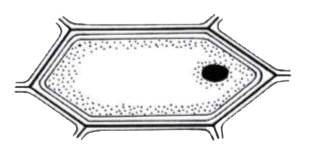Fatty substance found on epidermal cell walls is
(a) Cutin
(b) Suberin
(c) Wax
(d) Both (a) and (b)
The correct Answer is:A
Step-by-Step Solution:
1. Understanding the Question: The question asks for the fatty substance found on the epidermal cell walls of plants.
2. Identifying the Location: The fatty substance is present on the epidermal cell walls of the aerial parts of the plant, which are in contact with the atmosphere. This includes leaves and stems, but not roots, as roots are primarily involved in water absorption and do not have this fatty layer.
3. Identifying the Substance: The fatty substance that coats the epidermal cells is known as the cuticle. This cuticle serves as a protective layer for the plant.
4. Functions of the Cuticle: The cuticle provides several functions:
- It acts as a protective barrier against foreign substances, chemicals, and toxins.
- It is water-repellent, helping to prevent water loss from the plant's surface.
5. Composition of the Cuticle: The cuticle is mainly composed of two substances: cutin and cutan. These are the primary components that give the cuticle its fatty characteristics.
6. Analyzing the Options:
- Option A: Cutin - This is indeed the fatty substance found on the epidermal cell walls forming the cuticle.
- Option B: Suberin - This is another fatty substance but is found in the cell walls of cork tissue, not on epidermal cells.
- Option C: Wax - While the cuticle has waxy components, it is primarily made of cutin and cutan, making cutin the more accurate answer.
- Option D: Both A and B - Since Suberin is not found on epidermal cell walls, this option is incorrect.
7. Conclusion: Based on the analysis, the correct answer to the question is A: Cutin.
---
- It acts as a protective barrier against foreign substances, chemicals, and toxins.
- It is water-repellent, helping to prevent water loss from the plant's surface.
- Option A: Cutin - This is indeed the fatty substance found on the epidermal cell walls forming the cuticle.
- Option B: Suberin - This is another fatty substance but is found in the cell walls of cork tissue, not on epidermal cells.
- Option C: Wax - While the cuticle has waxy components, it is primarily made of cutin and cutan, making cutin the more accurate answer.
- Option D: Both A and B - Since Suberin is not found on epidermal cell walls, this option is incorrect.
Topper's Solved these Questions
- BOOK - CENGAGE BIOLOGY ENGLISHCHAPTER - ANATOMY OF FLOWERING PLANTS EXERCISE - ASSERTION-REASONING QUESTIONS14videos
ANATOMY OF FLOWERING PLANTS
- BOOK - CENGAGE BIOLOGY ENGLISHCHAPTER - ANATOMY OF FLOWERING PLANTS EXERCISE - ARCHIVES38videos
ANATOMY OF FLOWERING PLANTS
- BOOK - CENGAGE BIOLOGY ENGLISHCHAPTER - ANIMAL KINGDOMEXERCISE - Archives34videos
ANIMAL KINGDOM
Similar Questions
Knowledge Check
- Question 1 - Select One
The Secondary cell wall is present
Ainside the plasma membraneBinside the primary cell wallCoutside the middle lamellaeDoutside the primary cell wall
The figure given below shows the epidermal cells of an onion bulb. This cell was then transferred to a drop of sugar solution.

What scientific term is used for the changes as shown in epidermal cell as it would appear after immersion in a strong sugar solution.View SolutionThe structural polysaccharide found in plant cell walls is ................. while the storage polysacchaide found in seeds is.................
View SolutionMurein is found in the cell wall of:
View SolutionA waxy layer present outside the epidermal cells is absent in
View SolutionSoap box-like overlapping shells are found in the cell walls of
View SolutionMurein is not found in the cell wall of
View SolutionPhycocolloids are found in the cell walls of
View Solution

